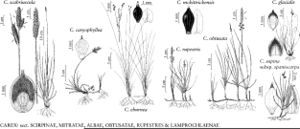Carex eburnea
in W. J. Hooker, Fl. Bor.-Amer. 2: 226, plate 225. 1839.
Culms 7–31 cm. Leaf-blades involute, bristlelike, 3–21 cm × 0.2–1 mm. Inflorescences: proximal bract sheaths 2.5–8 mm; pistillate spikes 3–7 × 1.5–6 mm; staminate spikes 3–10 × 0.5–1.5 mm, inconspicuous. Scales: pistillate scales white-hyaline, with green or brown midvein, ovate to ovate-circular, 1–2 × 0.7–1.4 mm, shorter than or equaling perigynia; staminate scales, white-hyaline, with broad hyaline margins, elliptic-oblanceolate, 2.6–4 × 0.7–2 mm, apex obtuse or subacute. Anthers 1.3–1.8 mm. Perigynia light green becoming dark-brown and glossy, 1.5–2.2 × 0.7–1.1 mm; beak 0.2–0.4 (–0.5) mm. Achenes ellipsoidobovoid.
Phenology: Fruiting late spring–mid summer.
Habitat: Usually in conifer or mixed forests, occasionally fens, stable dunes and alvar, on neutral or calcareous substrates
Elevation: 0–2000 m
Distribution

Alta., B.C., Man., N.B., Nfld. and Labr., N.W.T., N.S., Ont., Que., Sask., Yukon, Ala., Alaska, Ark., Conn., Ill., Ind., Iowa, Ky., Maine, Mass., Mich., Minn., Mo., Nebr., N.H., N.J., N.Y., N.C., N.Dak., Ohio, Pa., S.C., S.Dak., Tenn., Vt., Va., W.Va., Wis., c Mexico
Discussion
Selected References
None.
Lower Taxa
"shortened" is not a number."not undefined" is not a number.
